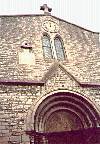History of Tournus
The origins:
The Saône valley, by its north-south orientation and its position in line with the Rhone channel, is a natural traffic axis, probably since the beginning of humanity.
The numerous prehistoric vestiges found in the surrounds prove very ancient settlements.
In the Caesar's times ("about 52 AC, a village of indomitable Gaul..."), the Eduens, people of the Celt Gaul, who build Bibracte (an important village on top of Mount Beuvray, about 100 kilometres north-west from Tournus) also lived on the Tournus site.
In Tournus, many vestiges of these times have been found (vestiges of the walls of the Roman castrum -fortified village- which one can still see in the south of the city, a Gallo-Roman ophthalmologist kit shown in the Greuze Museum...).
Scientists are also interested in some Merovingian (the first dynasty of French kings who ruled France from the middle of the Vth century to the middle of the VIIIth century) tombs.
The Middle Ages:
Probably since religious archives are often more complete, a wide part of Tournus history is also the history of its Abbey.
In 875 a chart signed by Charles le Chauve ("Bald" Charles, King of France) allows the foundation of a new Benedictine abbey in Tournus, dedicated to Saint Philibert (Saint Filbert).
This foundation ends 40 years of wandering life for the monks who came from Noirmoutier with Saint Philibert's relics. Their walk through France was interrupted by settlement trials in different places such as Saint-Philbert-de-Grandlieu (near Noirmoutier) or Saint-Pourçain-sur-Sioule (north from Clermont-Ferrand - west from Moulins). At many times these settlements were disturbed by attacks against the monasteries.
A monastery dedicated to Saint Valérien (Saint Valerian) was still existing at these times (the church is still there, a few yards from the Abbey).
After new adventures among them quarrels with the monks of Saint Valérien and several invasions and destruction by barbarians, the current Saint Philibert abbey was built in the end of the XIth century.
When at top of its power, the Tournus abbey has spread and rules about 10 religious communities, even in Provence. Its power decreases until the French Revolution of 1789.
 The burg already spreads from the ramparts of the Abbey to the south of the current town over the ancient castrum. Traders and workshops are grouped by profession giving their name to some streets (rue des Boucheries: Butchers Street, rue des Tanneurs: Tanners Street, rue de la Poissonnerie: Fishmongers Street, quartier de la Pêcherie: Fishers Area...).
The burg already spreads from the ramparts of the Abbey to the south of the current town over the ancient castrum. Traders and workshops are grouped by profession giving their name to some streets (rue des Boucheries: Butchers Street, rue des Tanneurs: Tanners Street, rue de la Poissonnerie: Fishmongers Street, quartier de la Pêcherie: Fishers Area...).
From Renaissance to Empire:
Since 1625 (but probably earlier) the town is managed by a Mayor already installed on the current Town Hall Place.
By the end of the XVIIIth century, the Town Hall was rebuilt and, in 1778, Emiland GAUTHEY, from Chalon directed the works. This architect will built some years later the Canal du Centre (Centre Channel). His Town Hall still stands in the centre town of Tournus.
In 1805, Napoleon travels to Italy and spends one night in Tournus. In the industrial estate named Pas Fleury, a commemorative plaque mentions that he slept in the building close to our R.N.6 (National Road 6). In thanks to the welcome of the Town, the Emperor gave funds to the Town for building the current quays. Let's say that the first bridge on the Saône was built only in the end of the year 1802! Users of this bridge paid a fee until the middle of the XIXth century. And the current bridge is the 5th one to be built in this place since 1802.
After their defeat in Russia, the Napoleonic troops come back to France pursued by the enemy. That's why the Austrians arrive in Burgundy in the beginning of 1814. When the town of Macon falls under Austrian attacks, 300 people from Tournus, soldiers, firemen, peasants and a few people from Chalon leave Tournus on January 23rd and help to free Macon. However, Napoleon must resign and is exiled in the Elbe Island in April 1814. Coming back for the 100 Days, the Emperor doesn't forget Tournus. He gives the Legion of Honour to the Town, on May 22nd, 1815 and allows Tournus to show this distinction in its coat of arms.
XXth century:
In the beginning of the century, phylloxera ravages vineyards in the whole France. For many years, no vineyard was seen in Tournus. Nowadays, the winegrowers of Tournus and Plottes offer controlled appellations of "Macon" and "Burgundy".
Industrials settle in Tournus: a manufacture of aluminium saucepans, a factory of electric accessories adds to the forges and other existing companies. This industrial tradition is still living even when the factories have changed their names and moved to other activities.
During the Second World War, the mountainous massif in the west of Tournus, with its forests, is appropriate to the settlement of Maquis that are very helpful to liberate the area. Men of the Resistance get the Liberation of Tournus in the evening of September 4th, 1944 while Nazi troops flow back when pursued by the Allied troops landed in Provence.
A collective work was published with the help of the Town Tournus in 1995: "Tournus, les Années noires" (Tournus, the dark Years). It relates the life in Tournus occupied by the Nazis, the life in the local Maquis and it is full of testimonies from people who lived in Tournus during these dark times. Many authentic documents are also printed in facsimile.
Since 1963, Tournus is twinned with the German town Germersheim.